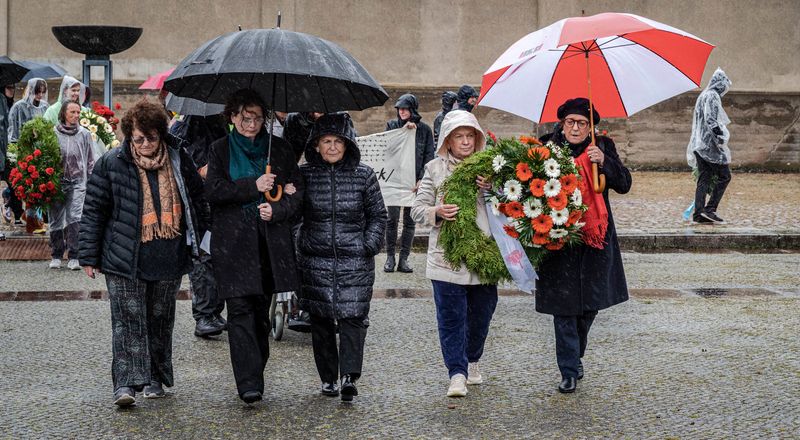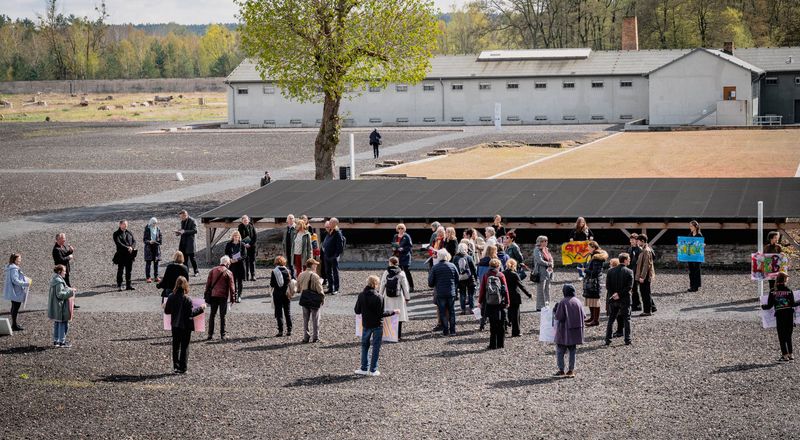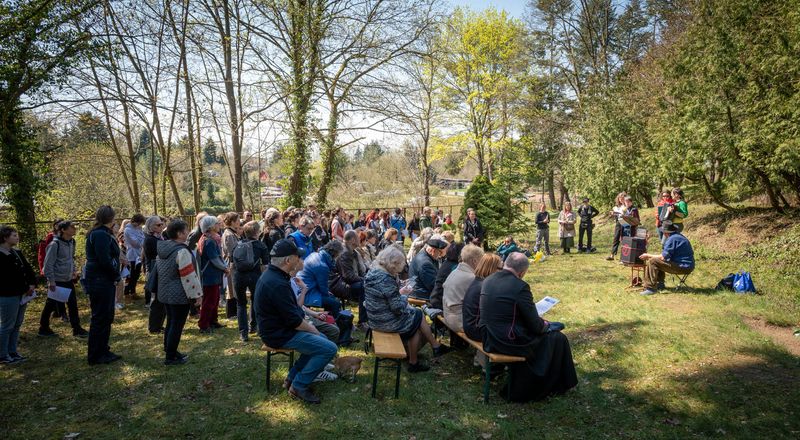From 20 to 30 April 2023, the Ravensbrück Memorial, together with the International Ravensbrück Committee, commemorated the liberation of the prisoners of the women's concentration camp by the Red Army 78 years ago with a comprehensive programme.
Central commemorative ceremony on 23 April 2023
Despite the pouring rain, the memorial welcomed around 300 guests to the central commemorative event, including Ravensbrück survivors Emmie Arbel (Israel), Irene Fainman-Krauß (South Africa), Ib Katznelson (Denmark), Barbara Piotrowska (Poland), Ingelore Prochnow (Germany) and Marla Tribich (Great Britain). Those present were welcomed by Dr Andrea Genest, Director of the memorial, Ambra Laurenzi, President of the International Ravensbrück Committee, and Robert Philipp, Mayor of Fürstenberg/Havel.
State Premier Dietmar Woidke emphasised the historical and current importance of memorial site work: ‘Memorial sites such as Ravensbrück are important places of learning that make the suffering of the victims tangible and contribute to raising awareness of the crimes of National Socialism.’
In his speech, Ib Katznelson, who was deported to Ravensbrück with his mother as a child, emphasised the responsibility of future generations to stand up against racism, anti-Semitism and violence.‘Ravensbrück should be a place where future generations learn that even verbal discrimination can lead to unimaginable suffering,’ said Katznelson, who was awarded the Order of Merit of the Federal Republic of Germany in January 2023.
Dr Irina Scherbakowa, co-founder of the Russian human rights organisation Memorial International, addressed the challenges of remembrance in light of the Russian war of aggression against Ukraine. She criticised the instrumentalisation of history by Russian propaganda and emphasised that the memory of the Second World War must also be an appeal for humanity and solidarity in the present.
Polish survivor Barbara Piotrowska recited the ‘Ravensbrück Lord's Prayer’, a prayer created in the camp. The event ended with a wreath-laying ceremony at the ‘Tragende.’ memorial.
Programme of Events
On 20 April 2023, the Rosa-Luxemburg-Stiftung in Berlin presented the graphic novel ‘Aber ich lebe. Four children survive the Holocaust’ was presented. Author Barbara Yelin and Ravensbrück survivor Emmie Arbel spoke together about the importance of drawings as a ‘colour of memory’ and about the collaborative development process of the book project.
Showcase of artistic works on 22 April 2023
On the afternoon of 22 April, students from the ‘Drawing and Printmaking’ class at the Muthesius Academy of Fine Arts and Design Kiel presented their artistic work in the memorial's former textile factory. The woodcuts and prints, which were created on site at the memorial centre at the beginning of March, dealt with the life of Gustav Fritz Herzberg, a prisoner who was persecuted as a homosexual and murdered in the Ravensbrück men's camp in 1942. The presentation took place in the presence of Xenia Trost, Herzberg's grandniece, and was part of a larger exhibition project that was on display at the memorial from June 2023.
On both days of the memorial weekend, the memorial offered tours, book and film presentations. Other centralised commemorative events were held by various initiatives and associations as part of the event.
The anniversary concluded with an online forum for the 2nd and 3rd generations, where descendants of former prisoners shared their perspectives.The event promoted dialogue about the passing on of memory and historical responsibility towards future generations.
Background
Between 1939 and 1945, 132,000 women, 20,000 men and 1,000 young women were registered as prisoners of the ‘Uckermark youth protection camp’ at Ravensbrück concentration camp. The prisoners came from over 30 nations and included numerous Jews as well as Sinti and Roma. Tens of thousands were murdered or died of starvation, disease or medical experiments. Following the construction of a gas chamber at the beginning of 1945, around 6,000 prisoners were gassed by the SS. At the end of April 1945, the SS drove tens of thousands of prisoners on death marches towards the north-west. 3,000 sick people left behind in the main camp were liberated by the Red Army on 30 April 1945.







